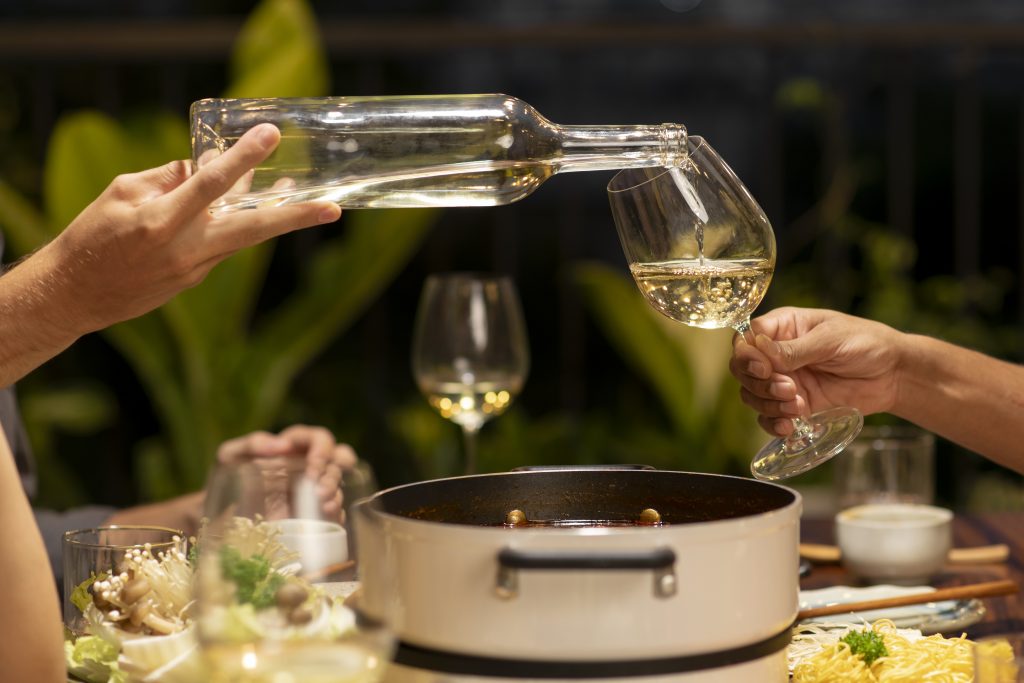Looking to enhance your knowledge and appreciation of white wines? Dive into ‘Your Ultimate Guide to Chardonnay White Wine.’ In this comprehensive article, you’ll explore the world of Chardonnay, a versatile grape that creates unique and complex wines. Discover its characteristics, flavors, and the regions where it thrives. Whether you prefer crisp or creamy, unoaked or oaked, you’ll find expert advice on serving, pairing, and storing this beloved white wine. Let’s embark on a delightful journey through the captivating world of Chardonnay.
Contents
- Chardonnay Varieties and Characteristics
- History of Chardonnay
- Chardonnay Tasting Notes
- Chardonnay Serving and Storage
- Chardonnay Wine Regions Around the World
- Characteristics of Chardonnay
- Flavors and Styles of Chardonnay
- Popularity and Versatility of Chardonnay
- Comparison With Unoaked and Oaked Chardonnay
- Serving, Pairing, and Other Information About Chardonnay
Chardonnay Varieties and Characteristics
When exploring the world of Chardonnay, it is important to understand its varieties and characteristics. The Chardonnay grape is a versatile white wine grape that can produce unique wines in different climates and soils. It can showcase the terroir or winemaking skill, producing dry or sweet wines, still or sparkling. Chardonnay can have flavors of green apples, minerals, toasty vanilla, or caramel. It can be lean and acidic or buttery and creamy. This moderate and neutral white grape easily absorbs the terroir of the vineyard, making it a favorite of winemakers. Chardonnay grows vigorously and requires careful pruning. Its early budding and thin skins make it susceptible to cool climates.
In terms of production techniques, Chardonnay can undergo malolactic fermentation, which reduces acidity and creates a rounder, creamier flavor. Aging potential varies for Chardonnay, with Grand Cru Chardonnays capable of aging for decades, while most are meant to be enjoyed young. When it comes to food pairings, Chardonnay is versatile and can be paired with a variety of foods depending on its style and weight. Lean styles pair well with shellfish, sushi, and sautéed fish, while oaked Chardonnays pair well with crab cakes, linguini vongole, and pork tenderloin. In terms of flavor profiles, Chardonnay can have primary flavors of lemon zest, chalky minerality, baked apple, and tropical fruits like pineapple. Secondary flavors like coconut, vanilla, and baking spices can come from the use of oak. Overall, understanding the varieties and characteristics of Chardonnay can enhance your appreciation and enjoyment of this popular white wine.
History of Chardonnay
To delve into the history of Chardonnay, let’s explore its origins and journey from Burgundy to becoming a global sensation. The Chardonnay grape, believed to be a cross between Pinot Noir and Gouais Blanc, first appeared in the 1600s in Mâconnais, Burgundy. It then made its way to Champagne in the late 18th century and thrived in Italy, being used in the production of Franciacorta. However, it wasn’t until the second half of the 20th century that Chardonnay gained popularity in California and Australia. The turning point came in 1976 with the Judgement of Paris, when Chardonnay from California beat French wines in a blind tasting, putting it on the international stage. Today, Chardonnay is grown in many wine regions around the world, from France to California, Italy to Australia. Its production involves careful winemaking techniques to bring out its unique flavors, and it can be aged to develop complexity. Chardonnay has become a favorite among wine lovers, with its versatility making it suitable for various occasions and food pairings. Its consumption continues to grow, solidifying its place as one of the most beloved white wines globally.
| Chardonnay Grape | |
|---|---|
| Origins | Burgundy, France |
| First Mentioned | 1600s |
| Journey | Burgundy – Champagne – Italy – California – Australia |
| International Recognition | Judgement of Paris, 1976 |
| Global Presence | Grown in many wine regions worldwide |
Chardonnay Tasting Notes
For a comprehensive understanding of Chardonnay white wine, let’s explore its tasting notes, which reveal the diverse flavors and characteristics that make this grape so beloved. Chardonnay, grown in various wine regions around the world, offers a range of flavor profiles. Old World Chardonnays from Burgundy and Chablis are complex and restrained, with high acidity, minerality, and flavors of green apple. Champagne Chardonnays exhibit high acidity, a creamy mouthfeel, and nuttiness. New World Chardonnays, particularly from California, are creamy, oaky, and full of tropical fruit flavors. The production methods also play a role in the flavor profiles of Chardonnay. Malolactic fermentation gives California Chardonnays their signature texture and flavor, while oak fermentation and aging create a round, creamy texture. When it comes to food pairing, lean Chardonnays pair well with shellfish and sautéed fish, while oaked Chardonnays complement dishes like crab cakes and pork tenderloin. Chardonnay also has aging potential, with Grand Cru Chardonnays being able to age for decades. Overall, the diverse flavor profiles, food pairing versatility, and aging potential make Chardonnay a beloved white wine grape.
Chardonnay Serving and Storage
To properly enjoy and preserve your Chardonnay white wine, it is important to understand the ideal serving and storage conditions. Here are some key points to keep in mind:
- Proper Chardonnay serving:
- Chardonnay should be served chilled, ideally between 45-55 degrees Fahrenheit.
- Use a white wine glass for most Chardonnays, as it allows the aromas to be fully experienced.
- Sparkling Chardonnays are best served very chilled, while leaner styles like Chablis should be served cooler.
- Oaked Chardonnays can be served slightly warmer to bring out the flavors.
- Chardonnay wine storage:
- Consistency in temperature is important for aging Chardonnay, with 55 degrees Fahrenheit being the recommended median temperature.
- Store unfinished Chardonnay in the refrigerator with the cork replaced to maintain freshness for 2-4 days.
- Chardonnay has aging potential, especially those labeled as Grand Cru, which can age for decades if stored properly.
Understanding these recommendations for serving and storage will enhance your Chardonnay drinking experience and ensure that you get the most out of your bottle.
Chardonnay Wine Regions Around the World
Now let’s explore the various wine regions around the world where Chardonnay thrives and produces exceptional wines. Chardonnay is a versatile grape that can adapt to different climates and soils, resulting in unique expressions of the wine. Here is a table showcasing some of the notable Chardonnay wine regions around the world:
| Region | Characteristics |
|---|---|
| Burgundy, France | Ancestral home of Chardonnay, producing complex and rich wines |
| Champagne, France | Known for high acidity, creamy mouthfeel, and nutty flavors in Chardonnay |
| California, USA | Second home to Chardonnay, offering a range of styles from vibrant citrus to opulent peach |
| Tuscany, Italy | Produces Chardonnays in the oaky California style, as well as sparkling wines in Franciacorta |
| South Australia, Australia | Noted for producing notable Chardonnays with tropical fruit flavors |
| Marlborough, New Zealand | Known for Chardonnays with bright fruit flavors and crisp acidity |
| Casablanca Valley, Chile | Offers good-value Chardonnays with balanced acidity and fruitiness |
| Mendoza, Argentina | Produces Chardonnays that are rich and full-bodied with tropical fruit notes |
| Finger Lakes, New York, USA | Emerging region for Chardonnay, producing quality wines with crisp acidity and vibrant fruit flavors |
These regions showcase the diversity of Chardonnay and the influence of terroir on the wine’s characteristics. Whether you prefer a crisp and mineral-driven Chardonnay from Chablis or a rich and buttery California-style Chardonnay, there is a region that will satisfy your taste preferences.
Characteristics of Chardonnay
When it comes to the characteristics of Chardonnay, there are three main aspects to consider: fruit, oak, and other flavors. Chardonnay can exhibit a wide range of fruit flavors, from apple and lemon to tropical fruits like papaya and pineapple. The use of oak in winemaking can add secondary flavors like vanilla and baking spices. Lastly, Chardonnay can also develop other flavors with age, such as hazelnut aromas.
Fruit
When exploring the fruit characteristics of Chardonnay, you will discover a wide range of flavors that can vary depending on the growing region and winemaking techniques. Here are some key points to understand about Chardonnay fruit:
- Chardonnay fruit flavors: Chardonnay grapes can produce flavors ranging from crisp green apple and citrus to tropical fruits like pineapple and papaya.
- Chardonnay grape characteristics: Chardonnay is a medium- to full-bodied grape with moderate acidity and alcohol levels. It can be light and elegant or full-bodied and buttery.
- Chardonnay production techniques: Winemakers can use different techniques like oak aging and malolactic fermentation to enhance the flavors and texture of Chardonnay.
- Chardonnay food pairing: Chardonnay’s versatility makes it a great match for a variety of foods. It pairs well with seafood, poultry, creamy pastas, and even some cheeses.
- Chardonnay aging potential: While some Chardonnays are meant to be enjoyed young, others, particularly those from Grand Cru vineyards, can age for several years, developing more complex flavors and aromas.
Understanding these characteristics will help you appreciate the diverse range of flavors and styles that Chardonnay has to offer.
Oak
Have you ever wondered how oak affects the characteristics of Chardonnay white wine? Oak aging plays a significant role in shaping the flavor profile of Chardonnay. When Chardonnay is aged in oak barrels, it absorbs the flavors and aromas of the wood, resulting in unique oak characteristics. Oaked Chardonnays often exhibit flavors of vanilla, baking spices, and toasted oak, adding complexity and richness to the wine. On the other hand, unoaked Chardonnays, which are not aged in oak, tend to showcase the pure fruit flavors of the grape. The choice between oaked and unoaked Chardonnay depends on personal preference, with oaked Chardonnays offering a creamier mouthfeel and additional layers of flavor. Whether you prefer the oak influence or the pure fruit expression, Chardonnay offers a range of options to please every palate.
Other
Chardonnay exhibits a wide range of characteristics, making it a versatile and popular white wine choice. When it comes to Chardonnay, there are several factors that contribute to its unique flavor profiles and qualities. Here are some key aspects to consider:
- Chardonnay aging: Chardonnay has the potential to age well, particularly the higher quality and more complex wines. With aging, Chardonnay can develop richer flavors and a rounder mouthfeel.
- Chardonnay food pairing: Chardonnay’s versatility makes it a great companion for various dishes. Its crisp acidity pairs well with seafood, sushi, and sautéed fish, while oaked Chardonnays complement creamier dishes like crab cakes and pork tenderloin.
- Chardonnay grape origins: Chardonnay originated from a cross between Pinot Noir and Gouais Blanc grapes. It has its roots in Burgundy, France, but is now grown in many wine regions around the world.
- Chardonnay winemaking techniques: Winemakers have different techniques for producing Chardonnay, which can greatly influence the wine’s flavor. Techniques such as oak fermentation and malolactic fermentation can add notes of vanilla, butter, and creaminess to the wine.
- Chardonnay flavor profiles: Chardonnay can range from lean and crisp with flavors of green apple and citrus, to full-bodied and buttery with notes of peach, mango, and lemon. The flavor profile of Chardonnay can vary depending on factors such as climate, harvest time, and winemaking techniques.
Flavors and Styles of Chardonnay
There are various flavors and styles of Chardonnay that cater to different preferences. Chardonnay offers a wide range of tasting notes depending on the region it is grown in and how it is made. Primary flavors of Chardonnay include lemon zest, chalky minerality, baked apple, and tropical fruits like pineapple. In cooler climates and earlier harvests, citrus notes are more apparent, while riper, richer fruits develop in warmer climates and later harvests. Secondary flavors like coconut, vanilla, and baking spices come from the use of oak. The buttery character of Chardonnay is a result of diacetyl, a byproduct of malolactic fermentation. Factors such as the origin and shape of the oak, toast level, and time in contact with the oak can also affect the flavors of Chardonnay. Winemakers often encourage malolactic fermentation to reduce acidity and create a rounder, creamier flavor. When it comes to serving Chardonnay, sparkling varieties should be served very chilled, lean styles like Chablis should be served cooler, and oaked styles should be served slightly warmer. Chardonnay pairs well with a variety of foods, with lean styles complementing shellfish, sushi, and sautéed fish, while oaked styles pair well with crab cakes, linguini vongole, and pork tenderloin.
Popularity and Versatility of Chardonnay
Chardonnay is a highly popular and versatile wine that appeals to a wide range of wine drinkers. Its popularity can be attributed to its ability to produce a variety of styles and flavors that cater to different preferences. Here are some key points to understand the popularity and versatility of Chardonnay:
- Chardonnay food pairing: Chardonnay’s versatility extends to its ability to pair well with a variety of foods. Its moderate acidity and diverse flavor profile make it a suitable companion for shellfish, sushi, sautéed fish, crab cakes, linguini vongole, pork tenderloin, and creamy dishes.
- Chardonnay aging potential: While most Chardonnays are meant to be enjoyed young, top-quality Chardonnays from Grand Cru vineyards have the potential to age for several decades. This aging process allows the wine to develop more complex flavors and aromas.
- Chardonnay winemaking techniques: Winemakers employ various techniques to create the desired flavor profile of Chardonnay. These techniques include oak fermentation and aging, malolactic fermentation, lees contact, and the use of different oak types and toast levels.
- Chardonnay flavor profile: Chardonnay exhibits a wide range of flavors, from crisp green apple and citrus notes in unoaked styles to peach, mango, and lemon with hints of vanilla and butter in oaked styles. Both styles often share an underlying note of apple or citrus.
- Chardonnay serving temperature: Chardonnay should be served chilled, ideally between 45-55 degrees Fahrenheit. This temperature range allows the wine to showcase its flavors and aromas without being too cold or too warm.
Comparison With Unoaked and Oaked Chardonnay
When comparing unoaked and oaked Chardonnay, you’ll notice distinct stylistic differences. Unoaked Chardonnay, also known as stainless steel Chardonnay, is crisp and bright. It is typically fermented and stored in stainless steel tanks, which allows the fruit flavors to shine through. This style of Chardonnay is known for its vibrant acidity, showcasing flavors of green apple, pear, and citrus. On the other hand, oaked Chardonnay is fuller-bodied with secondary flavors of vanilla and spice. It is aged in oak barrels, which imparts a creamy texture and adds complexity to the wine. Winemaking techniques such as oak fermentation and aging, as well as malolactic fermentation and lees contact, contribute to the rich and buttery characteristics of oaked Chardonnay. Additionally, terroir influence plays a role in shaping the flavors of Chardonnay. Different regions and vineyards can impart unique characteristics to the wine, such as minerality or tropical fruit notes. When it comes to food and wine pairing, unoaked Chardonnay pairs well with lighter dishes like shellfish and sushi, while oaked Chardonnay complements richer dishes like crab cakes and pork tenderloin. Ultimately, the choice between unoaked and oaked Chardonnay comes down to personal preference and the occasion.
Serving, Pairing, and Other Information About Chardonnay
To properly serve and pair Chardonnay, you should consider the ideal temperature and the types of dishes that complement its flavors. Here are some key points to keep in mind:
- Serving temperature:
- Chardonnay should be served chilled, ideally at 50-55°F.
- Too warm temperatures can mute flavors, while too cold temperatures can dull aromas.
- Food pairing:
- Lean styles of Chardonnay pair well with shellfish, sushi, and sautéed fish.
- Oaked Chardonnays are great with crab cakes, linguini vongole, and pork tenderloin.
- The acidity of Chardonnay complements creamier dishes.
- Vegetarians can pair Chardonnay with rich or starchy vegetables and mushrooms.
- Aging potential:
- Grand Cru Chardonnays can age for decades, while most are meant to be enjoyed young.
- Glassware choice:
- A white wine glass is suitable for most Chardonnays.
- Flutes are often used for sparkling Chardonnays.
- Storing options:
- Store unfinished Chardonnay in the refrigerator with the cork replaced.
- Freshness can be maintained for 2-4 days, after which the wine may start to oxidize.




